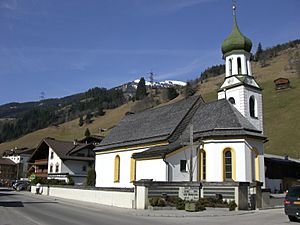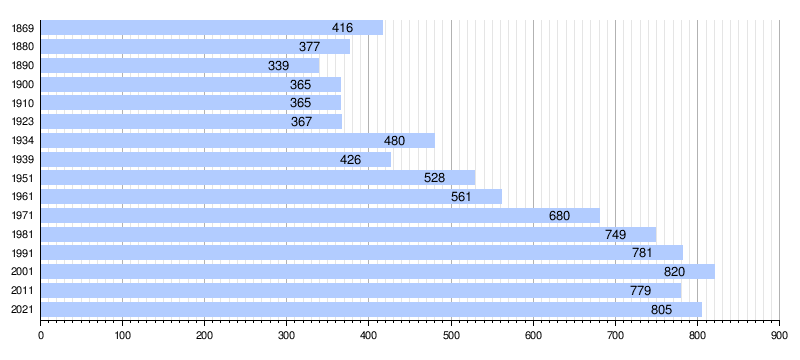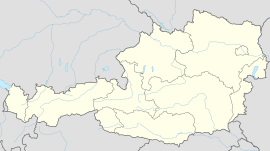Gerlos facts for kids
Quick facts for kids
Gerlos
|
||
|---|---|---|
 |
||
|
||
| Country | Austria | |
| State | Tyrol | |
| District | Schwaz | |
| Area | ||
| • Total | 118.91 km2 (45.91 sq mi) | |
| Elevation | 1,247 m (4,091 ft) | |
| Time zone | UTC+1 (CET) | |
| • Summer (DST) | UTC+2 (CEST) | |
| Postal code |
6281
|
|
| Area code | 05284 | |
| Vehicle registration | SZ | |
| Website | www.gerlos.tirol.gv.at | |
Gerlos is a small town, also called a municipality, in Austria. It is located in the Tyrol region, specifically in the Schwaz area. As of January 2019, about 793 people live there.
Gerlos is a popular spot for people who love to ski. Many families visit because it's easy to get to the Zillertal Arena ski center from here. The town is also part of the Zell am Ziller judicial district.
The municipality of Gerlos is made up of seven smaller areas: Au, Gmünd, Innertal, Mitterhof, Oberhof, Ried, and Schwarzach.
Contents
Geography
Gerlos is found in the Gerlos Valley, which is a side valley of the Zillertal. This valley branches off to the east near Zell am Ziller. The town itself is made up of several small groups of houses spread out along the Gerlos Pass. These homes are located on the valley floor, about 1,200 meters (around 3,900 feet) above sea level.
To the south of Gerlos, you'll find the Zillertal Alps. These mountains are very tall, reaching over 3,000 meters (about 9,800 feet). To the north, there's a ski area in the Kitzbühel Alps.
The total area of Gerlos is about 120 square kilometers (about 46 square miles). A large part of this area, about one-third, is covered by forests. Another quarter is high mountain land. The rest of the area is used for alpine pastures, which are fields where animals graze in the mountains. Only a small part, about three percent, is used for agriculture (farming).
History
In the 800s, the Archbishop of Salzburg gained control of large areas of land in the Zillertal. At that time, the only direct way to travel between Salzburg and its lands in Tyrol was a difficult mule track. Later, in the 1300s, several special farms called "Schwaighöfe" were set up in places like Gmünd, Ried, and Oberhof. These farms focused on raising livestock and making dairy products.
Before 1470, Gerlos was part of the main church area of Zell am Ziller. A Gothic church was built in Gerlos around 1470. The tower of St. Lambert's and the Leonhard church were built around 1500. The church you see in Gerlos today still has parts of these older buildings. Other parts of the church were built in 1735. Gerlos officially became its own church parish in 1891.
The name "Gerlos" was first written down in a document from 1507. It was called "saltus gerlaise," which means "Gerlos Pass." The name "gerlaise" likely comes from old words meaning "pointed property" and "wild stream." The forests of Gerlos were also mentioned in the same year.
The area became very busy when gold was found in nearby towns like Hainzenberg and Zell am Ziller. Gold was also discovered in Gerlos itself. People mined for gold there from the 1600s until 1870. The Gerlos Pass was also important during the Tyrolean Rebellion in 1809. During this time, soldiers from Pinzgau invaded Tyrol using the pass.
For many centuries, the Gerlos Pass was the most important route between Tyrol and Salzburg. However, the roads were in poor condition even in the late 1800s. In 1866, a newspaper wrote that the Gerlos roads had very steep slopes (20%), bumpy paths, and sharp turns. There were plans to build a railway line, but it never happened.
Construction of a new road began in 1910, but it faced many problems like landslides. A new road on the Salzburg side was finally finished in 1962. It took two more years for the road on the Tyrolean side to be fully open. Around this time, the Funsingau Hydroelectric power plant was also built, which uses water to create electricity.
The number of people living in Gerlos has generally increased over time, though it has gone up and down in recent years.

Culture
Gerlos has five buildings that are considered important for their culture and history. One example is the Gerlos parish church, which you can see in the picture.
Economy and Infrastructure
Tourism
The economy of Gerlos relies on a few main things. One is generating electricity using the Funsingau power plant. Another is farming. But a very important part of the economy is tourism, especially for skiing.
Gerlos has the third-highest number of winter visitors in the Zillertal area, after Mayrhofen and Tux. From 2010 to 2019, the number of people staying overnight in Gerlos during the winter grew from 590,000 to 670,000. February is usually the busiest month for skiing, with about 125,000 overnight stays.
Summer is also a popular time to visit Gerlos. August is especially busy, with 774,000 overnight stays in 2019. However, the 2020 ski season was greatly affected by the COVID-19 pandemic. The total number of overnight stays for the whole year dropped to 486,444. In February, the number of visitors was much lower, at only 139,347.
Traffic
The main road that goes through Gerlos is called the Gerlosstrasse. This road connects Zell am Ziller to Mittersill. There is also a bus service that runs during certain seasons from Zell am Ziller, where the Zillertalbahn train station is located.
Sports
Gerlos offers many fun sports and activities:
- Swimming in the Durlassboden reservoir
- Hiking in the Kitzbühel Alps
- Via ferrata (a climbing path with fixed cables) in Riederklamm
- Mountain biking
- Piste skiing in the Zillertal Arena
- Ski touring (skiing in the backcountry)
Notable People
Some interesting people are connected to Gerlos:
Honorary citizens
- Berthold Beitz (1913-2013) - He helped start the Zillertal ski area.
- Peter Haas (1927-2017) - He was a Kapellmeister (music director) and Choirmaster in the village for a long time.
- Johann Kammerlander (1926-2017) - He was a former mayor of Gerlos and a restaurateur (someone who owns or manages a restaurant).
Gerlos born
- Simon Geisler (1686-1931) - He was a politician.
Associated
- Anja Haas (born 1971) - She is an alpine skier who trains in Gerlos.
- Franz Hörl (born 1956) - He is a politician and runs a hotel in the village.
See also
 In Spanish: Gerlos para niños
In Spanish: Gerlos para niños



